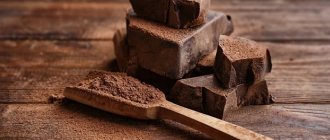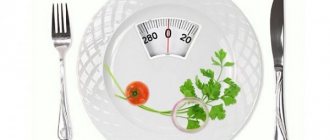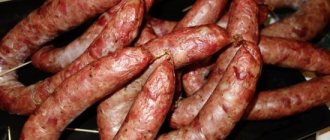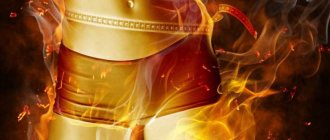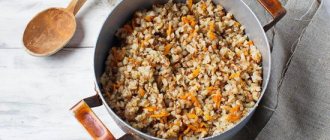Popcorn is a favorite treat for adults and children. Without it, it’s hard to imagine going to the cinema, zoo or many other entertainment places. You can buy it or prepare it yourself, and for some people it has become a way to earn money. With the help of specialized equipment, it is very easy to open your own outlet for the production and sale of this product.
Many people who care about their figure are interested in how many calories are in popcorn and are in no hurry to buy it. Let's figure out what popcorn is, what it comes in and how high in calories it is.
What is popcorn
This product is made from certain varieties of corn grains. When exposed to heat, the starch they contain ruptures the outer shell and turns into a foamy white substance. To achieve this effect, corn kernels were previously fried in oil. It is natural that this method of processing significantly increased the calorie content of the finished product. Currently, specialized machines are used for making popcorn. They allow you to heat the grains without using copious amounts of oil, further improve the taste of this delicacy, and increase the convenience of the cooking process itself. Accordingly, the calorie content of such popcorn becomes lower than fried in oil.
The benefits of popcorn for the body
Photo pixabay.com
So, using our instructions, you have made yourself a healthy snack. Let's find out what she can do to please you.
Popcorn is very low in calories
If you cook popcorn with olive oil, then you will have 35 calories in one serving. Is it a lot or a little? For comparison, 100 grams of store-bought crackers with various flavors contain 420 calories, in chips - from 500 (if we add to this the presence of not the most healthy additives, then the question of which is more harmful, chips or popcorn, disappears by itself).
Popcorn may be healthier than fruits and vegetables
Yes, you read that right. According to a 2022 study published in the journal Antioxidants, popcorn contains polyphenols, compounds found in plants that act as antioxidants and reduce inflammation.
Polyphenols are highly diluted in fruits and vegetables, which are 90 percent water. However, popcorn is about four percent water, so its polyphenols are more concentrated, especially in the hard shells that tend to get stuck in teeth.
However, it is worth noting that on the other hand, popcorn does not contain many vitamins and nutrients, so it cannot completely replace fruits and vegetables in your diet.
Popcorn may help fight cancer (and more)
One of the many properties of polyphenols found in popcorn is their ability to block enzymes that cancer needs to grow, and thus, as noted by the American Institute for Cancer Research, these compounds help regulate the spread of cancer cells.
Since polyphenols can also prevent inflammation and plaque, popcorn can contribute to oral hygiene and the prevention of cardiovascular disease.
Popcorn is an excellent source of whole grains
Popcorn is the only snack that is 100 percent unprocessed whole grain. Just one serving contains more than 70 percent of the recommended daily intake for this food group.
This Snack May Help Relieve Constipation
Because popcorn is a whole grain, the insoluble fiber in it helps keep your digestive tract in check and prevent constipation.
One serving of this snack contains 3.5 grams of fiber, and according to the US Food and Drug Administration, a high-fiber diet may promote bowel regularity.
This is the perfect diet snack
High-fiber foods take longer to digest than non-fiber foods, so they help you feel fuller longer. So snacking on popped popcorn between meals can keep you from reaching for sweets or fatty foods.
Popcorn is good for diabetics
Although fiber is listed under total carbohydrates on food labels, it does not have the same effect on blood sugar as refined carbohydrates (such as white bread).
High-fiber foods do not contain as many easily digestible carbohydrates, so they slow down the rate of digestion and cause a more gradual and lower rise in blood sugar. According to a 2015 study published in the journal Circulation, diabetics benefit from popcorn popped without butter and with a little sea salt.
Popcorn has more iron than spinach
Not much, but it's true! According to the USDA, 28 grams of popcorn contains 0.9 mg of iron, while 30 grams of raw spinach contains about 0.8 mg. These numbers seem low, but adult men only need 8 mg of iron per day.
How many calories are in sweet popcorn
This is the version of the product that is most often offered to children. The calorie content of sweet popcorn is directly determined by the amount of sweeteners and additives (syrup, icing, etc.). Usually it is 550±150 kcal. The minimum energy value of popcorn sweetened only with syrups and powdered sugar is in the range of 400–600 kcal. The presence of a caramel (glazed) coating makes the product crispy and at the same time increases its calorie content to 700±100 kcal.
How to make healthy popcorn
Buy plain kernels - preferably organic (since most corn is now the GMO variety and grown with lots of pesticides).
Next, heat a frying pan over medium heat with a little healthy oil, such as coconut or olive oil. Place the grains in the frying pan and close it with a lid (no need to reduce the heat). Now, without removing the lid, shake the pan several times and cook the popcorn until the grains stop “exploding.”
Don't want to eat bland popcorn? There are many more filling options than just butter and salt. Add cinnamon or apple pie spice if you're craving something sweet, or spice it up with wasabi or curry if you like it a little spicier.
To give your appetizer an Italian flavor, add grated Parmesan and a small amount of olive oil. Basically, anything in your spice cabinet can add flavor to your popcorn without adding more calories to your snack.
You can make popcorn part of your healthy diet - just don't overdo it with butter and salt. By the way, the recommended serving size is about 30 grams
.
Is it worth eating popcorn at all?
So, we found out that the calorie content of salty, sweet or flavored popcorn is quite high. Is it worth using such a product? If you love popcorn, then you shouldn’t deny yourself the treat! In addition, corn grains contain many useful substances, including iodine, magnesium, zinc, potassium, B vitamins, and fiber that cleanses the body. But in order not to harm your figure and health in general, adhere to the following rules when eating popcorn.
Eat small meals. Remember that the calorie content of the daily diet is on average 2000 kcal (for an adult leading a moderately active lifestyle). Therefore, foods with medium and/or high energy value, which include popcorn, should be consumed in moderate portions.
Choose a natural composition. The “safest” popcorn is considered to be home-cooked popcorn. You can squeeze a little salt or sugar syrup, lemon juice or other natural flavor enhancers into it.
If you buy ready-made popcorn, pay attention to the type of additives.
Combine foods correctly. It is not recommended to use salted popcorn as a snack for beer, especially for people who are prone to accumulating extra pounds. Do not combine sweet varieties of the product with other high-calorie treats (cakes, pastries, etc.).
To learn more about equipment for preparing your favorite delicacy, contact.
Healthy snack or junk food?
Photo pixabay.com
Popcorn is a snack whose benefits and harm to the body directly depend on how it was prepared. If you do this correctly (we will tell you exactly how), then you will get a lot of benefits from using it; if not, be prepared for unpleasant consequences from such a snack.
So, let's take a closer look at popcorn and take a look at both of its “guises.”
Popcorn in the diet of those watching their figure
The most rational method of making popcorn at the diet stage is considered to be the classic one:
- Puffed corn helps satisfy the feeling of hunger without creating a feeling of heaviness.
- It can be used as a snack, because it is better than chocolate or cookies. For such a snack, it is better to cook grains without oil and on the stove.
- Nutritionists also advise eating popcorn instead of bread. This delicacy helps speed up the metabolic process and, as a result, leads to weight loss.
- Corn also contains beneficial B vitamins, which prevent the onset of stress and depression, which is important at the stage of losing weight, because often stress causes excess weight or at the stage of quitting the diet.
- To improve the taste without harming your figure, you can add garlic or cinnamon. They will enhance the taste and aroma, add zest and increase appetite.
The main thing to remember is that popcorn is a high-calorie treat and should be consumed in small quantities.
Popcorn has a lot of positive properties, but also negative ones. There are several variations of it, but the most harmless is the one prepared at home. Some categories of people should approach the consumption of this delicacy with caution.
If you are at the stage of weight loss, then popcorn will help you achieve the desired results due to its positive properties.
An important condition: the quantity and frequency of its use is considered. You shouldn't abuse it. Now you know everything about the benefits and harms of popcorn and you can safely add it to your diet.
Microwave recipes at home
You can’t make popcorn from regular corn from the garden or from the store. It requires special varieties of corn, the grains of which have a glassy, thin but durable shell.
There are several interesting varieties:
| Corn variety | Characteristics |
| Red popcorn | Interesting for its original red-brown color and pleasant taste. This variety has low shoots and small cobs - no more than 15 cm long. |
| Gobble-gobble | High-yielding, easy to care for, ripens fairly quickly. The cobs are about 20 cm in size and weigh 200-250 g. The grains themselves are large, wide, bright yellow, great for making popcorn. |
| Volcano | Characterized by a tall stem. From one cob more than 20 cm long you can collect 100-120 g of excellent grains. This plant is also absolutely unpretentious in care and resistant to adverse weather factors. |
| Zeya | It is distinguished by the original shape of the grains - wide, long, with a rounded top, copper-red color. Plus, corn of this variety also ripens early. |
Any of these varieties can be grown in your own garden, but you should not mix them with regular corn: due to cross-pollination, the quality of the special variety may suffer. After harvesting, the cobs must be dried for a month in a cool, dry place.
The calorie content of salted popcorn practically does not depend on the type of corn.
Ready-made dry grains for making popcorn can be bought in the supermarket and at the market.
Having selected the appropriate variety of corn, popcorn can be easily prepared at home in several ways:
- In the microwave.
- You will need any deep microwave-safe dish. Pour oil at the rate of 1 tbsp. l per 1 liter of container volume.
- First, you need to sprinkle the grains in a thin layer so that each one is bathed in oil, taking into account that 25 g of dry grains will turn into 1 liter of the finished product.
- Then the dishes should be tightly closed, placed in the microwave and turned on at maximum power.
- Next, you need to listen carefully: first, frequent claps will begin, then the sound will be heard less and less often. After about 3 minutes, when the intervals between the claps are at least 6 seconds, the microwave can be turned off.
- Having taken out the bowl with popcorn, carefully open it with the lid facing you, pour it into a dry bowl and cool the finished popcorn.
- In a slow cooker.
- This is the easiest way, since you don’t have to monitor the process.
- It is enough to put all the ingredients (25 g of grains and 1 tablespoon of vegetable oil) into a bowl with a volume of at least 1 liter, stir, close and turn on the required mode, for example, “Frying” or “Baking”.
- After 5 min. the treat is ready.
- In a frying pan.
- This method requires constant attention, but you can reduce the amount of oil, which will significantly reduce the calorie content of the product.
- You need to take a deep frying pan with a thick bottom, pour oil into it so that the bottom closes, then, when it is not hot enough, pour dry corn grains into one even layer, shake so that all the grains are evenly coated with oil.
- Cover the pan with a lid and continue heating, shaking the pan periodically to open up as many beans as possible.
- Listen to the popping sounds, and when they almost stop, remove the pan from the heat and immediately open the lid so as not to soak the finished popcorn with condensation.
- In a saucepan.
- This method is convenient because you can cook a large volume of popcorn at a time in a wide pan. The main thing is that the pan has a thick bottom and a tight lid.
- Put it on medium heat, pour in a layer of oil no more than 2 mm, as soon as it warms up, pour dry corn in the same thin layer, shake, cover with a lid or a special splash screen.
- Just as with other methods, listen carefully to the claps. Remove from heat when the popping stops.
Before cooking corn grains in any way, you should keep them in the freezer for half an hour, then, due to the sharp temperature difference, the exploding process will occur faster. Any refined vegetable oil will do. To get popcorn with additives, you need to dissolve them in oil in advance.
Nutritional value of popped popcorn
Puffed popcorn is made without oil or vegetable oil, so it is the lowest in calories. In such a cup with air there are:
- Calories: 31
- Total fat: 0.4 grams
- Carbohydrates: 6.2 grams
- Dietary fiber: 1.2 grams
- Protein: 1 gram
The simplest ones consist primarily of carbohydrates, followed by protein. We can consider unbuttered popcorn as a healthy snack given that it is very low in calories and contains heart-healthy fiber.
Unhusked corn kernels
Popcorn hulls are made up of fat, protein, carbohydrates and water. When heated, pressure builds inside and the kernel expands and explodes, creating edible popcorn.
If you've ever read the label on a container of corn kernels, you may have wondered why popcorn contains fewer calories when it's popped. Two tablespoons of unopened grains contain:
- Calories: 110
- Total fat: 1.5 grams
- Carbohydrates: 22 grams
- Dietary fiber: 4 grams
- Protein: gram 3
What can create confusion between popped and whole kernels is that when popped, popcorn expands to 35 to 40 times the size of the kernel. So while two tablespoons of kernels for 110 calories may seem like a lot, once cooked, this amount will yield about 4 cups of popcorn.
